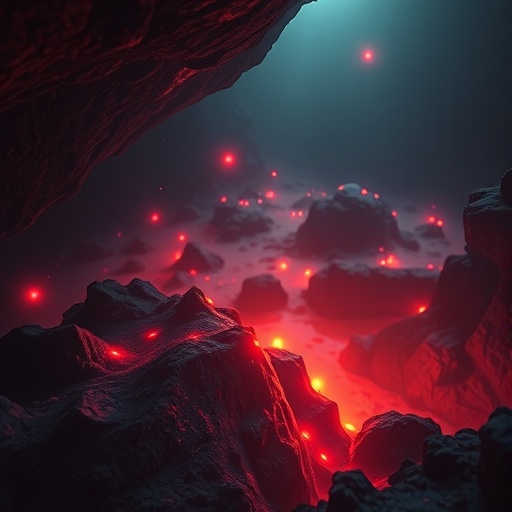A newly published study unveils compelling evidence of deep microbial colonization driven by hydrothermal circulation initiated by an ancient meteorite impact. The research, performed at the Lappajärvi impact structure in Finland, reveals how subsurface life thrived in an environment transformed by the intense heat and fluid movement following a celestial collision. This finding not only advances our understanding of life’s resilience on Earth but also opens exciting avenues for astrobiology, including the search for life on other planets shaped by similar impact events.
Impact craters have long been recognized as environments of geological upheaval, yet their potential as niches for deep microbial ecosystems has remained underexplored. The study sheds light on how post-impact hydrothermal systems can create habitable environments kilometers beneath the surface, where thermophilic microorganisms may colonize rock fractures enriched with nutrients and energy sources. This challenges previous notions that impact sterilization predominates over biological colonization in such environments.
Lappajärvi, a well-preserved impact crater formed around 76 million years ago during the late Cretaceous period, offers an exceptional natural laboratory for examining these processes. Researchers focused on hydrothermal circulation systems generated by the transient heating of subsurface rocks immediately following the impact event. These systems facilitate fluid-rock interactions, driving chemical gradients critical for microbial metabolism. The study applied an integrated suite of analytical techniques to characterize both the geological and biological signatures of this subsurface biosphere.
Using advanced petrographic analysis coupled with nanoscale geochemical profiling, the team identified distinct mineralogical alterations consistent with hydrothermal fluid activity. Altered rock matrices exhibited secondary mineral precipitates such as silica and carbonate cements along vein networks—a signature of fluid flow pathways. These features correlate spatially with microbial biosignatures, including complex biofilm-like microstructures preserved within mineralized veins.
Molecular analyses further confirmed the presence of thermophilic and chemolithotrophic microbial communities adapted to the nutrient-rich, high-temperature conditions created by hydrothermal circulation. The microbial inhabitants appear to derive energy through oxidation-reduction reactions involving sulfur and iron compounds liberated by water-rock interactions. This revelation demonstrates how impact-generated hydrothermal systems can host diverse, metabolically specialized subsurface ecosystems.
Intriguingly, these biological communities persisted for hundreds of thousands of years after the impact, sustained by continued geothermal gradients and fluid availability. The endurance of such ecosystems contrasts sharply with the traditionally perceived ephemerality of post-impact hydrothermal habitats. This finding suggests that impact craters may not only act as biological frontier zones in Earth’s deep biosphere but also as cradles for early life in planetary history.
The study’s multi-modal approach, combining microscopy, isotope geochemistry, and microbial DNA sequencing, sets a new benchmark in characterizing ancient subsurface biospheres. Isotopic signatures of carbonate minerals reveal carbon cycling dynamics influenced by microbial activity, while sulfur isotope fractionation points to active sulfate reduction. These nuanced geochemical footprints coalesce into a robust dataset confirming biogenicity rather than abiotic mineral precipitation.
Beyond Earth, the implications for astrobiology are profound. Impact craters on Mars and icy moons such as Europa or Enceladus frequently host subsurface hydrothermal systems that might replicate conditions found at Lappajärvi. Understanding how life exploits such transient yet energetically fertile niches refines models of extraterrestrial habitability and guides future exploratory missions in the solar system.
This research also prompts reconsideration of Earth’s early biosphere evolution. The young, volatile-rich crust exposed to frequent impacts during the Hadean and Archean eons may have harbored extensive hydrothermal habitats conducive to life’s emergence and diversification. Impact structures, once thought inimical to life due to catastrophic destruction, emerge as paradoxical sanctuaries facilitating microbial colonization.
Moreover, the study highlights the critical role of fluid-rock interactions in modulating subsurface habitability. Hydrothermal fluids transport and concentrate essential elements while generating steep chemical and thermal gradients harnessed by microorganisms. These gradients constitute ecological niches otherwise absent in static geological settings, reaffirming the dynamic interplay between geology and biology.
The Lappajärvi project exemplifies the synthesis of earth sciences and microbiology needed to expose the deep biosphere’s complexity. It also demonstrates how drilling campaigns targeting impact structures can unlock fossil and extant records of microbial ecosystems thriving under extreme conditions. These insights reshape the boundaries of known habitable environments on Earth.
Future research directions emerging from this work encompass precise quantification of fluid residence times, microbial population dynamics, and metabolic network analyses under impact-induced hydrothermal regimes. Coupling such studies with experimental simulations will elucidate the limits of life and its adaptability to rapid environmental transformations. These endeavors bear consequences for biotechnology, biogeochemistry, and planetary protection strategies.
Equally, the findings underscore the need to re-examine other terrestrial impact craters worldwide as potential reservoirs of deep life. Comparative analyses across diverse geological contexts will unravel how variations in impact size, target rock composition, and geothermal evolution influence microbial colonization patterns. This cross-disciplinary frontier promises breakthroughs in both fundamental biology and applied geosciences.
The involvement of international research consortia and state-of-the-art instrumentation was pivotal to the success of this investigation. Collaborative efforts spanning microbiology, geochemistry, planetary science, and geology brought an unprecedented depth of understanding to phenomena previously obscured beneath kilometers of rock and time. This integrative framework marks a paradigm shift in exploring Earth’s hidden life and anticipating life’s tenacity beyond it.
In summary, the study conducted at the Lappajärvi impact structure delivers definitive proof that deep microbial ecosystems can establish and flourish within hydrothermal systems instigated by meteorite impacts. This challenges existing dogmas about impact environments and broadens the contexts in which life might thrive in the universe. As humanity continues to probe our planet and beyond, such discoveries will fuel the quest to comprehend life’s origin, evolution, and ubiquity.
Subject of Research: Deep microbial colonization in impact-generated hydrothermal systems at the Lappajärvi impact structure, Finland.
Article Title: Deep microbial colonization during impact-generated hydrothermal circulation at the Lappajärvi impact structure, Finland.
Article References:
Gustafsson, J., Osinski, G.R., Roberts, N.M.W. et al. Deep microbial colonization during impact-generated hydrothermal circulation at the Lappajärvi impact structure, Finland. Nat Commun 16, 8270 (2025). https://doi.org/10.1038/s41467-025-63603-y
Image Credits: AI Generated




